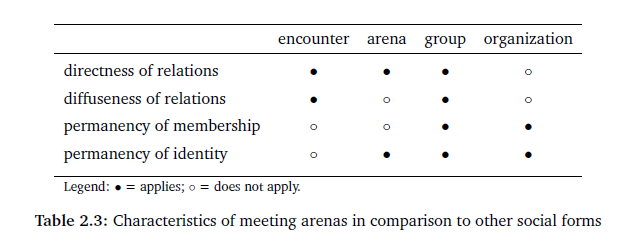That reminds me that I also used Luhmann in my doctoral thesis (pp. 85-87) to try and grasp what is unique about meeting arenas in comparison to other social forms/ concepts. I say “meeting arenas” to distinguish the meeting as a structure or setting from the meeting as an activity. (I have developed this idea in my Organizing Spaces article: doi: 10.1177/0170840613479232.) So here is how I made sense of things back then (2010):

Luhmann distinguishes interaction systems, organizations, and societies
Luhmann (1975b) distinguishes three types of social systems: interaction systems, organizations, and societies. Each of these represents an increase of stability over time. What interests us here are interaction systems and organizations. Simple interaction systems (or what Goffman calls “encounters”) are based on mutual perception of the interactants and cease to exist as soon as the interactants disperse (Luhmann 1972/1975a: 32). This means that the system only exists as long as the interactants have individual motives to sustain the interaction.
In organizations, on the other hand, individual motives in a certain situation becomes irrelevant due to “membership rules—such as deference to authority in exchange for a salary” which generalize the motives among the membership: organizations make members act according to a certain pattern because they are members of that organization and regardless of their individual motivation in a particular situation. In that way, organized social systems can continuously pursue an organizational goal rather independent of the individual motivations of its members (Luhmann 1975b: 12).
Neidhardt adds Groups to the picture
Neidhardt (1994a: 137) convincingly argues that groups should be added to Luhmann’s typology as a fourth type of social system located somewhere in between simple interaction systems (encounters) and organizations. He defines a group as a social system with (1) direct, (2) diffuse, and (3) relatively permanent relations amongst its members. The relations in a group are direct in the sense that every member and can interact directly with every other member. These interactions are not limited by specific ends or goals (as in organizations) but “occur in various respects on a formally undefined number of reference levels. . . . [T]heir communication has a relatively open horizon and multilayered modes of expression” (ibid.: 136); in that sense they are diffuse. Groups share these two characteristics with encounters but not with organizations (Table 2.3).
What distinguishes groups from encounters is the third characteristic, their relative permanency: in contrast to the fugacity of encounters, groups have the capacity to subsist latently: “You belong to the family, the regulars’ table [Stammtisch], and the clique of colleagues even in the lull between their gathering” (ibid.: 137). In fact, private communication between parts of the membership may occur outside group meetings so that, in a sense, a group can be quite active even when it is not assembled in an encounter.
Meeting arenas share some characteristics with each of these types (Table 2.3). The relations among meeting participants are direct, like in encounters and groups, but different to organizations. Similar to organizational members, the relations of meeting participants are not diffuse since arenas are created for a more or less specific purpose and the meeting participants are expected to frame their relations in terms of that purpose. Even the most generally defined meeting arena has the purpose that participants discuss common business, and not private matters, for example.
In order to understand the role of permanency, I distinguish two dimensions comprised in Neidhardt’s notion of ‘permanency’: permanency of membership and permanency of identity. Groups and organizations subsists latently even when their members are temporarily dispersed because their membership status as well as a sense of shared identity remain.
The interesting point is that also meeting arenas continue to exist latently as a more or less institutionalized meeting place, but this permanency is not due to permanency in membership (because it has no membership) but only to the permanency of the arena’s identity which is known in a wider collectivity of participants as well as non-participants. This identity may be closely connected to a physical place and a set of written rules, but it can also exist virtually and informally. The repetition of similar meetings for a certain purpose creates a tradition that establishes the arena’s identity. In that sense, a meeting arena is organized, but not necessarily part of an organization.
Conclusion
To conclude, meeting arenas reflect the hybrid characteristics of organizing processes in social movements. Without turning into a formal organization and without degenerating into ephemeral encounters, (successful) mesomobilization arenas provide a meeting space where organizing processes can be coordinated without turning the movement into an organization.